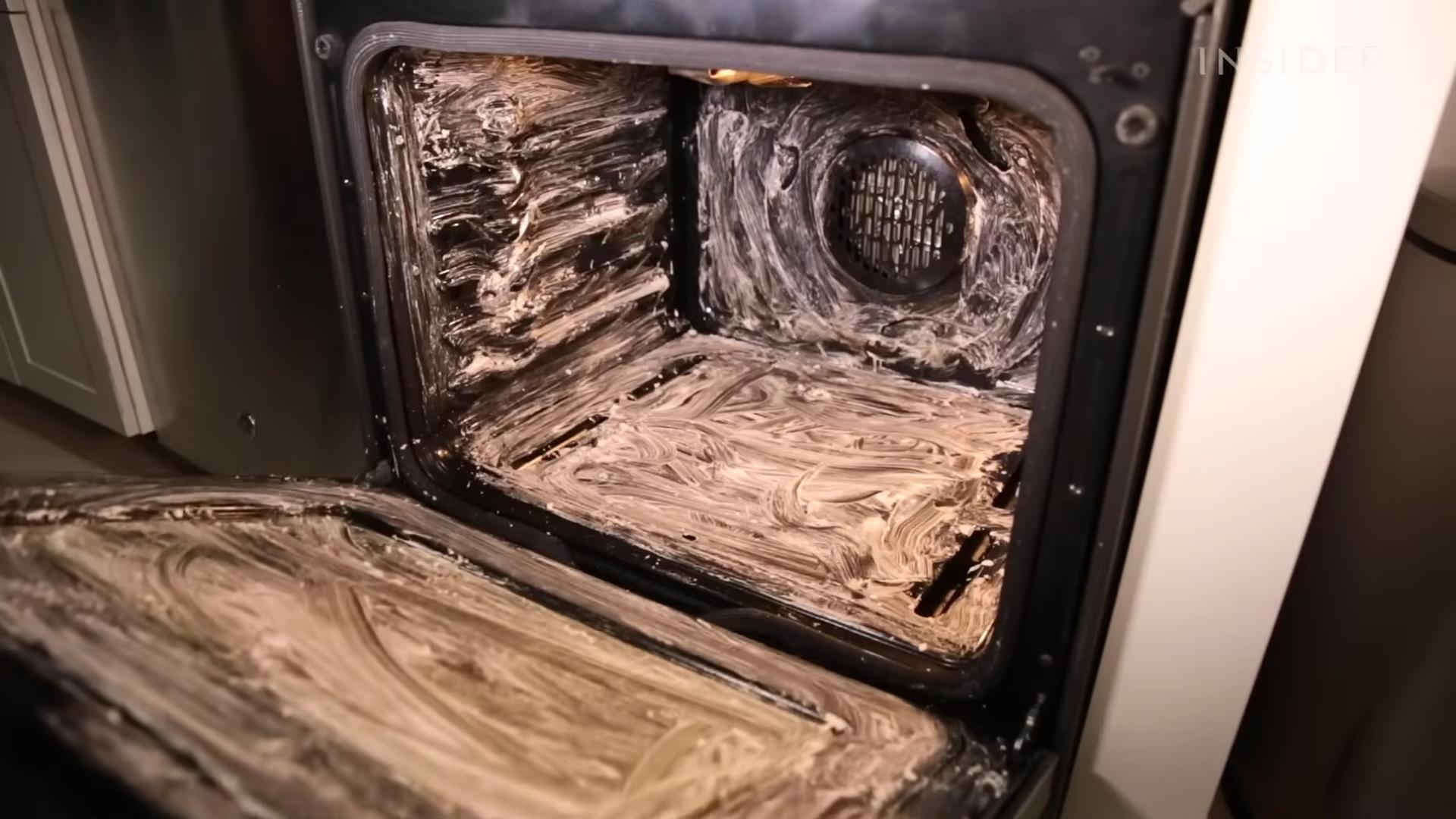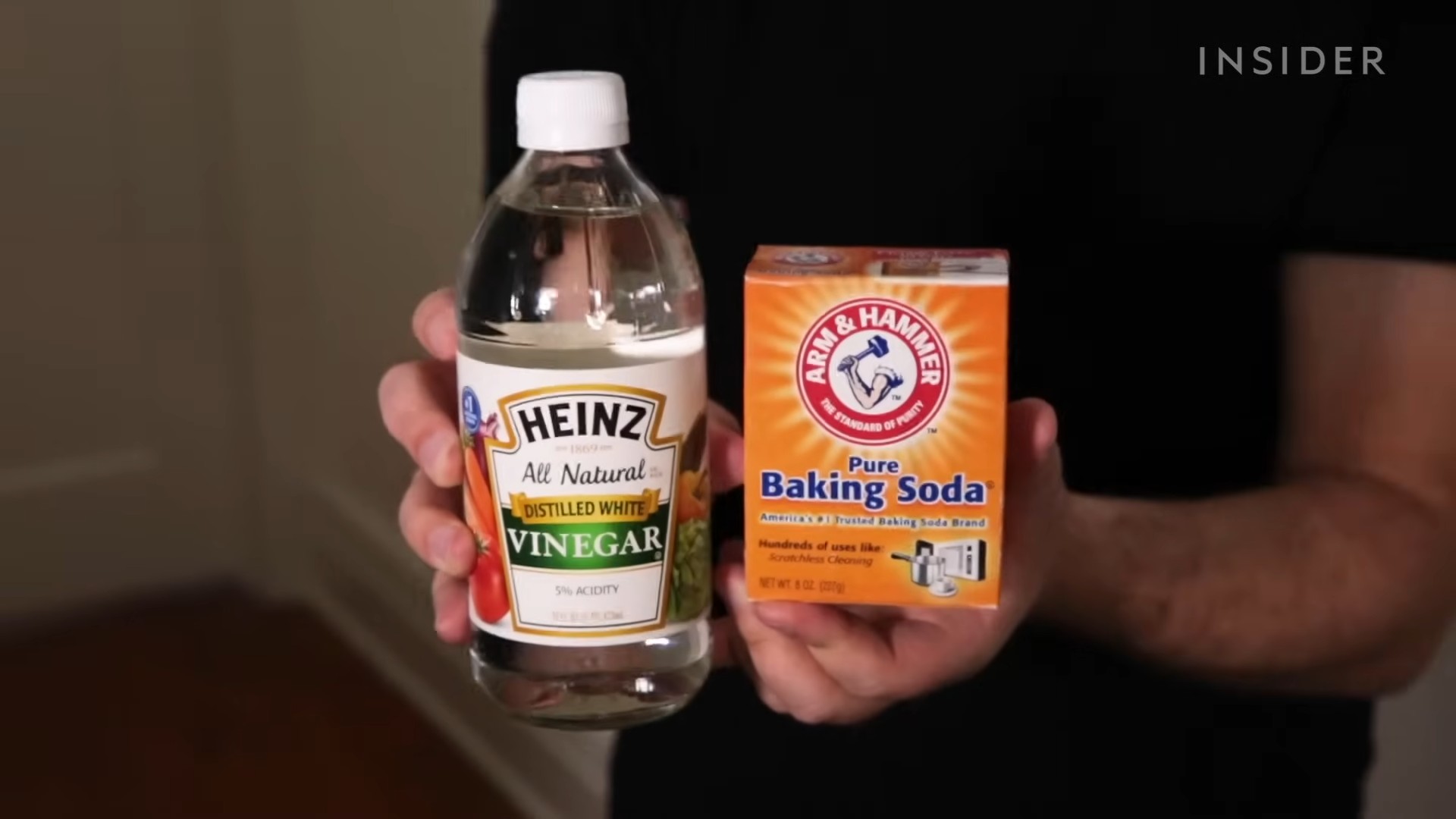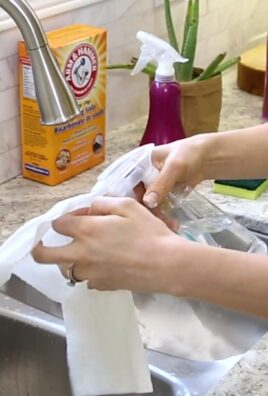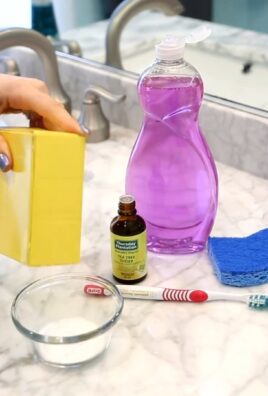Natural oven cleaning – sounds like a dream, right? I know, I know, the thought of tackling that greasy, burnt-on mess inside your oven can be downright daunting. But what if I told you there’s a way to get your oven sparkling clean without harsh chemicals or back-breaking scrubbing?
For generations, resourceful homemakers have relied on simple, natural ingredients to keep their homes clean and fresh. Before the age of commercial cleaning products, things like vinegar, baking soda, and lemon were the go-to solutions for everything from disinfecting surfaces to removing stubborn stains. This tradition of natural cleaning is not only effective but also kinder to our planet and our health.
Let’s face it, nobody enjoys breathing in the fumes of chemical oven cleaners. Plus, those products can be expensive and potentially harmful to your family and pets. That’s where this DIY trick comes in! I’m going to share a simple, yet incredibly effective method for natural oven cleaning that uses ingredients you probably already have in your pantry. This hack will not only save you money and protect your health but also leave your oven looking brand new. Get ready to say goodbye to harsh chemicals and hello to a sparkling clean oven, the natural way!

DIY Natural Oven Cleaning: A Sparkling Oven Without Harsh Chemicals
Okay, let’s face it, cleaning the oven is probably on everyone’s list of least favorite chores. But it doesn’t have to be a toxic nightmare filled with harsh chemicals! I’m going to show you how to get your oven sparkling clean using ingredients you probably already have in your pantry. This method is not only effective but also much safer for you, your family, and the environment.
What You’ll Need:
Before we dive in, let’s gather our supplies. This is a pretty simple list, which is one of the things I love about this method!
* Baking soda
* White vinegar
* Water
* Spray bottle
* Spatula or scraper (plastic is best to avoid scratching)
* Microfiber cloths or sponges
* Rubber gloves (optional, but recommended)
* Small bowl
* Old towel or newspaper (to protect your floor)
Step-by-Step Instructions:
Alright, let’s get started! I promise, it’s easier than you think.
Phase 1: The Baking Soda Paste
This is where the magic begins. Baking soda is a fantastic natural cleaner and deodorizer.
1. Prepare the Oven: First things first, remove the oven racks. I usually soak them in hot, soapy water in my sink while I’m working on the oven itself. This will help loosen any baked-on grime. Also, remove any large pieces of food debris from the bottom of the oven. An old spatula or scraper works wonders for this. Lay down an old towel or newspaper around the base of your oven to catch any drips or spills.
2. Make the Paste: In your small bowl, mix together about ½ cup of baking soda with enough water to form a spreadable paste. You’re aiming for a consistency similar to frosting. Add the water gradually, mixing as you go, until you achieve the right texture. It shouldn’t be too runny or too thick.
3. Apply the Paste: Now, put on your gloves (if you’re using them) and generously spread the baking soda paste all over the inside of your oven. This includes the walls, the bottom, the door (inside), and even the heating elements (if you can reach them safely). Avoid the heating elements if you’re not comfortable reaching them. I usually use my hands to apply the paste, but you can also use a spatula or a sponge.
4. Be Thorough: Pay special attention to any areas with baked-on grease or food stains. You can apply a thicker layer of paste to these areas. The key is to make sure every surface is covered.
5. Let it Sit: This is the most important part! Once you’ve applied the paste, close the oven door and let it sit for at least 12 hours, or even better, overnight. The longer it sits, the more time the baking soda has to work its magic and loosen the grime. I usually do this before I go to bed so it can work its magic while I sleep.
Phase 2: The Vinegar Power
The next day (or after at least 12 hours), it’s time to unleash the power of vinegar!
1. Prepare the Vinegar: Pour some white vinegar into your spray bottle. You don’t need to dilute it; we’re using it full strength.
2. Spray the Vinegar: Generously spray the vinegar all over the baking soda paste inside your oven. You’ll notice that the vinegar reacts with the baking soda, causing it to fizz. This is exactly what we want! The fizzing action helps to further loosen the grime.
3. Let it Fizz: Let the vinegar and baking soda react for a few minutes. You’ll see the paste start to bubble and loosen.
4. Wipe it Down: Now, using your microfiber cloths or sponges, start wiping away the baking soda and vinegar mixture. You might need to use a little elbow grease, especially in areas with stubborn stains. Rinse your cloths or sponges frequently in warm water.
5. Scrape Away Stubborn Residue: If you encounter any areas where the paste is particularly difficult to remove, use your spatula or scraper to gently scrape it away. Be careful not to scratch the oven surface.
6. Rinse and Repeat: Continue wiping and scraping until you’ve removed all of the baking soda and vinegar mixture. You might need to rinse and repeat this process several times to get your oven completely clean.
Phase 3: The Final Touches
Almost there! Just a few more steps to a sparkling clean oven.
1. Final Wipe Down: Once you’ve removed all of the baking soda and vinegar mixture, give the inside of your oven one final wipe down with a clean, damp cloth. This will remove any remaining residue and leave your oven looking shiny and new.
2. Clean the Oven Racks: Remember those oven racks you soaked in hot, soapy water? Now it’s time to clean them. Use a sponge or scrub brush to remove any remaining grime. Rinse them thoroughly with clean water and let them dry completely.
3. Dry Everything: Use a clean, dry cloth to dry the inside of your oven and the oven racks. This will prevent any water spots from forming.
4. Reassemble: Once everything is dry, put the oven racks back into the oven.
5. Optional: Run the Oven: I like to run my oven at a low temperature (around 200 degrees Fahrenheit) for about 15-20 minutes to make sure everything is completely dry and to burn off any lingering odors. Keep an eye on it and make sure nothing is smoking.
Tips and Tricks for Success:
* Don’t be afraid to experiment: If you find that the baking soda paste isn’t working as well as you’d like, you can try adding a little bit of dish soap to the mixture. Just be sure to rinse thoroughly.
* For really tough stains: You can try making a paste of baking soda and hydrogen peroxide. Apply it to the stain, let it sit for a few minutes, and then scrub it away.
* Prevent future messes: To prevent future messes, try lining the bottom of your oven with aluminum foil or a baking sheet. This will catch any drips or spills and make cleanup much easier.
* Regular cleaning is key: The more often you clean your oven, the easier it will be to keep it clean. Try to clean it at least once a month, or more often if you use it frequently.
* Ventilation is important: While this method is natural, it’s still a good idea to open a window or turn on your kitchen fan while you’re cleaning your oven.
Why This Method Works:
You might be wondering why this simple method is so effective. Here’s the science behind it:
* Baking Soda: Baking soda is a mild alkali, which means it can dissolve grease and dirt. It’s also a natural deodorizer, so it will help to get rid of any lingering odors in your oven.
* Vinegar: Vinegar is a mild acid, which helps to break down mineral deposits and other stubborn stains. When it reacts with baking soda, it creates carbon dioxide gas, which helps to lift dirt and grime away from the oven surface.
Safety First!
While this method is much safer than using harsh chemicals, it’s still important to take a few precautions:
* Wear gloves: Even though baking soda and vinegar are natural, they can still irritate your skin. It’s a good idea to wear rubber gloves to protect your hands.
* Avoid getting the mixture in your eyes: If you do get the mixture in your eyes, rinse them immediately with plenty of water.
* Don’t mix with other cleaners: Never mix baking soda and vinegar with other cleaning products, as this could create dangerous fumes.
* Unplug the oven: Before you start cleaning, make sure your oven is unplugged to prevent any electrical accidents.
And there you have it! A sparkling clean oven without the harsh chemicals. I hope you found this guide helpful. Happy cleaning!

Conclusion
So, there you have it! Ditching the harsh chemicals and embracing this natural oven cleaning method is more than just a trend; it’s a game-changer for your kitchen, your health, and the environment. We’ve walked you through a simple, effective process that utilizes ingredients you likely already have in your pantry: baking soda, vinegar, and a little bit of elbow grease.
But why is this DIY approach a must-try? Firstly, it’s incredibly cost-effective. Think about the money you’ll save on expensive oven cleaners filled with questionable ingredients. Secondly, and perhaps more importantly, it’s safe. No more worrying about lingering fumes or accidental skin contact with corrosive chemicals. You can clean your oven with peace of mind, knowing you’re not introducing harmful substances into your home. Thirdly, it’s surprisingly effective. The combination of baking soda’s gentle abrasiveness and vinegar’s acidic power works wonders on baked-on grease and grime.
Beyond the basic method, there are a few variations you can explore to tailor the cleaning to your specific oven and preferences. For instance, if you have particularly stubborn stains, you can add a few drops of lemon essential oil to the baking soda paste for extra degreasing power and a fresh scent. Alternatively, for ovens with self-cleaning functions that you’re hesitant to use due to the high heat and fumes, this natural method can serve as a fantastic pre-cleaner, loosening up the grime before you run the self-cleaning cycle on a shorter, less intense setting. You can also use a pumice stone very gently on the glass door to remove baked-on residue, but be extremely careful not to scratch the glass. Always test in an inconspicuous area first.
Consider using a dedicated spray bottle for your vinegar solution. This will make the application process much easier and more controlled. Also, remember that patience is key. Allowing the baking soda paste to sit overnight is crucial for breaking down the stubborn grime. Don’t rush the process!
We truly believe that once you try this natural oven cleaning method, you’ll never go back to conventional cleaners. It’s a simple, safe, and effective way to keep your oven sparkling clean and your kitchen a healthier space.
Now, it’s your turn! We encourage you to give this DIY trick a try and see the amazing results for yourself. Don’t be afraid to experiment with the variations and find what works best for your oven. And most importantly, we want to hear about your experience! Share your before-and-after photos, your tips and tricks, and any modifications you made in the comments below. Let’s create a community of clean oven enthusiasts who are passionate about natural cleaning solutions! Your feedback will not only help others but also inspire us to continue sharing valuable DIY tips and tricks. Let us know if you have any questions, and happy cleaning!
Frequently Asked Questions (FAQ)
Q: How often should I use this natural oven cleaning method?
A: The frequency depends on how often you use your oven and how much it tends to get dirty. For ovens used regularly, a deep clean every 1-3 months is generally sufficient. However, if you notice spills or splatters, it’s best to clean them up immediately to prevent them from baking on and becoming more difficult to remove later. Spot cleaning with a damp cloth and a little baking soda paste can be done as needed between deep cleans.
Q: Can I use this method on a self-cleaning oven?
A: Yes, absolutely! In fact, this natural method is a great alternative to using the self-cleaning function, which can produce unpleasant odors and consume a lot of energy. You can also use this method as a pre-cleaner before running the self-cleaning cycle on a shorter, less intense setting. This will help to loosen up the grime and reduce the amount of time and energy required for the self-cleaning cycle. However, always consult your oven’s manual before using any cleaning method, even natural ones.
Q: What if I have a particularly stubborn stain that won’t come off?
A: For stubborn stains, try these tips:
* Reapply the baking soda paste: Apply a thicker layer of baking soda paste to the stain and let it sit for an extended period, even up to 24 hours.
* Use a scrub brush: After the paste has sat, use a stiff-bristled scrub brush or an old toothbrush to scrub the stain vigorously.
* Add lemon juice: The acidity of lemon juice can help to break down tough grease and grime. Add a few tablespoons of lemon juice to the baking soda paste or spray the stain with lemon juice before applying the paste.
* Pumice Stone (Use with extreme caution): For glass oven doors only, a very gently used pumice stone can help remove baked-on residue. Wet the stone and the glass thoroughly and rub very gently in a circular motion. Test in an inconspicuous area first to ensure it doesn’t scratch the glass.
Q: Is it safe to use vinegar on all oven surfaces?
A: Vinegar is generally safe to use on most oven surfaces, including stainless steel and enamel. However, it’s always a good idea to test it in an inconspicuous area first to ensure it doesn’t cause any discoloration or damage. Avoid using vinegar on ovens with aluminum interiors, as it can react with the metal.
Q: What if I don’t have baking soda or vinegar? Are there any alternatives?
A: While baking soda and vinegar are the most effective and readily available natural cleaning agents, you can try a few alternatives:
* Cream of Tartar: Mix cream of tartar with water to form a paste and apply it to the oven surfaces. Let it sit for a few hours before scrubbing and rinsing.
* Borax: Mix borax with water to create a cleaning solution. Borax is a stronger cleaner than baking soda, so use it with caution and wear gloves.
* Lemon Juice: As mentioned earlier, lemon juice can be used as a degreaser and stain remover.
Q: My oven has a strong odor after cleaning. How can I get rid of it?
A: If your oven has a lingering odor after cleaning, try these tips:
* Ventilate the kitchen: Open windows and doors to air out the kitchen.
* Bake lemon slices: Place lemon slices in a baking dish and bake them at 350°F (175°C) for 30 minutes. The lemon will help to absorb the odor.
* Place a bowl of baking soda: Leave a bowl of baking soda in the oven overnight to absorb any remaining odors.
* Wipe down with a damp cloth: Wipe down the interior of the oven with a damp cloth and a few drops of essential oil, such as lemon or lavender.
Q: Can I use this method to clean the oven racks?
A: Yes, you can use this method to clean the oven racks. Soak the racks in a mixture of hot water and baking soda for several hours or overnight. Then, scrub them with a brush and rinse thoroughly. For stubborn grime, you can also add some dish soap to the soaking solution. Alternatively, you can place the racks in a large trash bag with a cup of ammonia overnight. Be sure to do this in a well-ventilated area and wear gloves. The ammonia fumes will help to loosen the grime, making it easier to scrub off.
Q: Is this method safe for people with allergies or sensitivities?
A: This natural oven cleaning method is generally safe for people with allergies or sensitivities, as it doesn’t involve harsh chemicals or strong fragrances. However, if you have known allergies to baking soda or vinegar, it’s best to wear gloves and avoid direct contact with the ingredients. If you’re concerned about potential reactions, you can also test the cleaning solution on a small, inconspicuous area of your skin before using it on the oven.




Leave a Comment